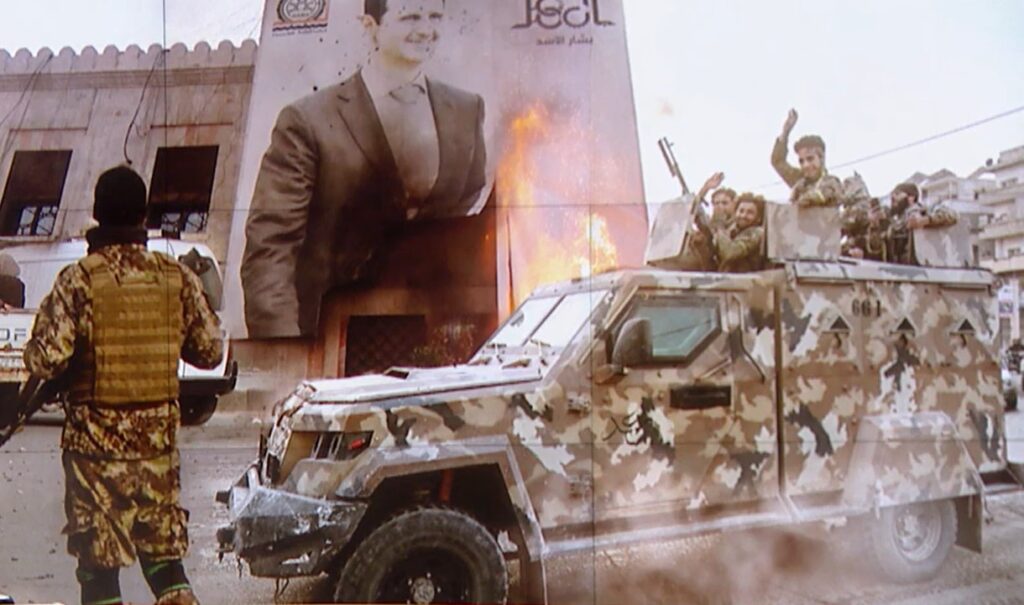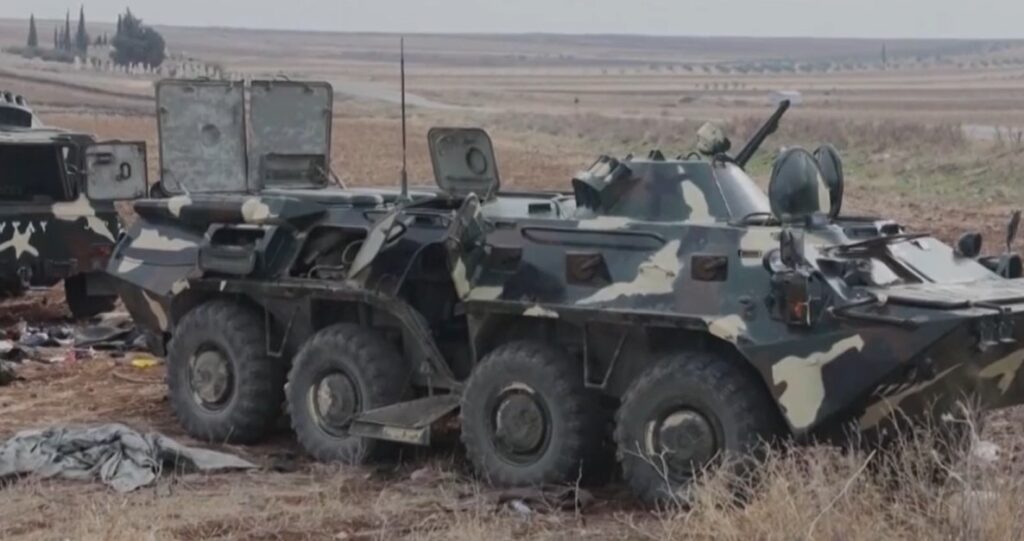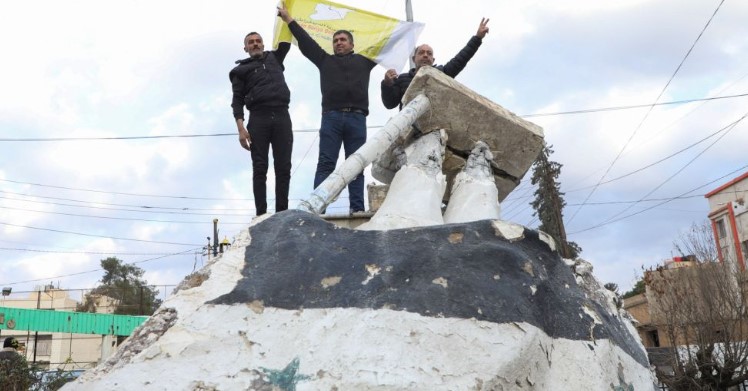By John Pickard
The astonishing speed with which rebel forces advanced south from Aleppo to take the Syrian capital was not so much a measure of their military prowess as the complete absence of support for the overthrown dictator Bashir Assad. The brutality of his regime and its temporary ‘victory’ in a twelve-year civil war led to the complete hollowing out of his political and military support.
Even in the minority Alawite community, which was Assad’s main base, there was a war-weariness and a yearning for peace. Poorly paid conscript soldiers, already battle-fatigued and disenchanted with Assad, are no basis for winning a renewed war.
The rebel force, Hayat Tahrir al-Sham (HTS) is a split off from Al-Qaida in Syria, and after the sudden attack on Aleppo and then Homs, they rapidly moved south to take Damascus. Statues of Bashir Assad and his father Hafez al-Assad, have been toppling all over Syria; pictures have been torn down and burnt and crowds have celebrated his fall, waving Syrian flags in the streets and from balconies.
Bashir Assad, like his father, was a bloody dictator who would resort to any atrocity – and did – to maintain his grip on power. The overarching strategy in a long civil war was blitzkreig, to reduce the areas held by rebels to piles of rubble, and mop up the opposition afterwards. Many parts of the major cities and smaller towns were reduced to a moonscape. Some estimates put the cost of repairing the physical damage in Syria at a minimum of $150bn and full reconstruction possibly as high as $400bn.
Three and a half million fled the war
A million Syrians have lost their lives and many more have been injured. Three and a half million have fled the country, many to Europe, but most to Turkey. Half of the population has been internally displaced. A survey by the International Rescue Committee in Idlib five years ago found “that families living there had on average moved five times since the start of the civil war – with 16 per cent reporting they had been displaced 10 times or more.” (Financial Times, February 17, 2020).

Assad was supported in the war by thousands of members of Hezbollah, from Lebanon, but more importantly, with weapons and firepower from Iran and Russia. It has been in the main Russian aircraft that have wreaked destruction on Syrian towns and cities. With this outside support, it was thought that the civil war was largely won, except for the city of Idlib in the north, held by the forces of the HTS, and other areas close to the Turkish border held by the ‘Syrian National Army’ a proxy of Ankara.
It was already an indication of the weariness within the forces of the Assad regime that the state has not been able – for five years – to retake Idlib from the rebels, or oust the US troops from their base in the Kurdish area in the North West.
As a result of his support for Assad, Putin was able to strengthen the Russian naval base on the northwestern coast of Syria, at Tartus. With Damascus taken by rebels and Assad having fled, there are now reports that the Russians have evacuated their base. If their departure does indeed become permanent, then the fall of Assad will mean a serious strategic setback for Russia in the Middle East.
Hayat Tahrir al-Sham has no interest in workers or democratic rights.
What does the fall of Assad mean for Syrian workers? There is no doubt that for the corrupt and murderous dictatorship of Assad the interests of ordinary workers was at the bottom of a long list of priorities. But it would be making a mistake to imagine that the victory of the HTS is a victory for workers. It is not. The leader of that group, Abu Mohammad al-Jawlani, has reportedly distanced himself from at least some of the fundamentalist ideas of ISIS and Al-Qaida from which it split, but he is no ‘democrat’.
ISIS and Al-Qaida were Sunni Muslim – as are the majority of the Syrian population – and at first sight that alignment may appear to threaten the interests of the Christian and Alawite minorities, the latter closer to Shia Islam. But there are also reports that Jolani has made some overtures to religious minorities, in order to smooth his path to victory. But the ‘tolerance’ of Hayat Tahrir al-Sham remains to be seen.
As for all of the workers, youth, women and students who have spilled onto the streets of Syrian towns, waving Syrian flags, they too, may find that their hopes are dashed. HTS is not an organisation that is any way ‘friendly’ to the interests of workers.

The BBC reported that In Damascus, al-Jawlani addressed crowds in the ancient Umayyad mosque in the city centre. “Assad’s regime”, he said, “imprisoned thousands of its own citizens unjustly and without any crime”, adding that “today, we are rewarded with this victory. This victory is for all Syrians.”
Fine words. But short of an independent movement of the working class – and in the horrors of civil war any remnants of it were wiped out – there is virtually no chance of Assad’s fall leading to ‘democracy’ or the exercise of freedoms like the right to strike, demonstrate or oppose the new regime. Al-Jawlani plays to the cheering crowds today, but he will not do the same tomorrow.
Overthrow of Assad injects a new note of instability in the region
Across the Middle East as a whole, the fall of Assad, far from ushering in a new phase of ‘stability’ is likely to do the opposite. It is true that the Israeli attacks on Hezbollah had weakened it so much that it was no longer able to provide assistance to Assad. The Israeli Prime Minister, Benjamin Netanyahu, gloated about the fact. He suggested that his country’s attacks on Iran and the Lebanon-based Hizbollah militant group “had set off a ‘chain reaction’ throughout the region”, adding “We extend a hand of peace to our . . . neighbours who want to live in peace with Israel.” (Financial Times),
Israel’s new “neighbours” will not take kindly to the incursion of Israeli tanks into Syrian territory in the last few days, or, for that matter, the permanent annexation of the Syrian territory known as the Golan Heights. Israel has apparently launched air strikes at security complexes in Damascus. This is almost like a calculated bid to make sure that a newly unified Syria is hostile to Israel. Netanyahu’s political career clearly thrives on war or the threat of war.
There might also be the sound of crowing in the White House, not only for the fall of Assad, but for the discomforting of Russia as well. But, again, we will see how the new government responds to the presence of 900 US forces personnel on its territory. These were originally put there by Trump during his first administration. “I left troops in Syria” he said, in an accidental fit of honesty, “only for the oil”.
Far from bringing in a new period of peace and harmony, the fall of the dictator Assad – at the hands of a reactionary quasi-religious rebel group – is likely to bring a lot more headaches for Donald Trump than he is qualified to handle. He may find he can’t have “the oil” or, for that matter, keep his troops in the new Syria.
[Pictures: from Al Jazeera newsfeed.]



